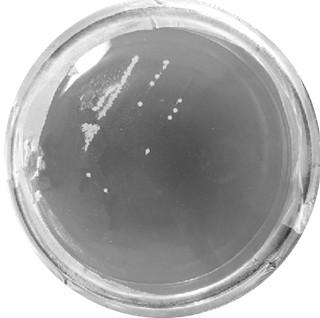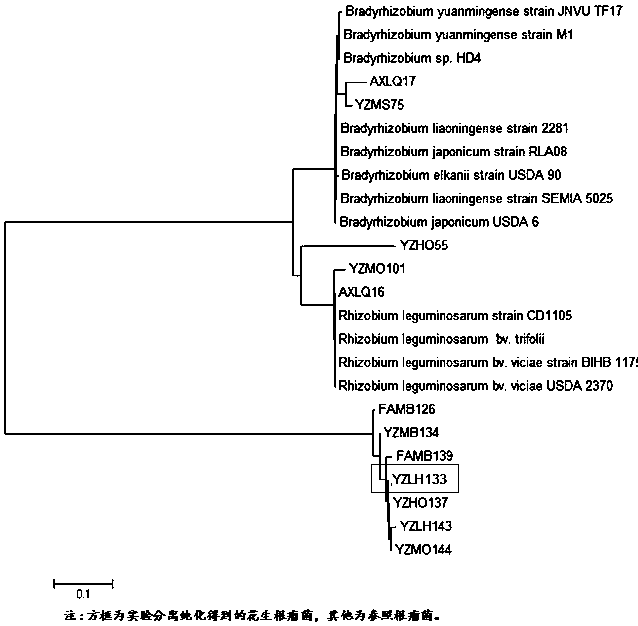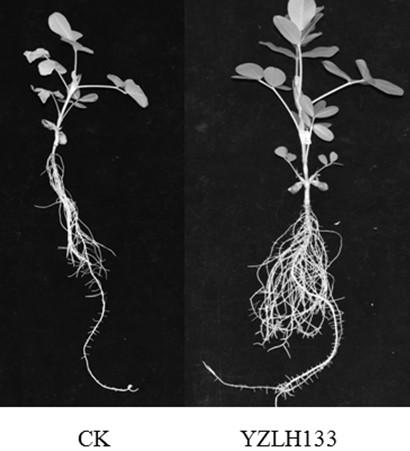Rhizobium YZLH133 and application thereof
A technology of rhizobia and bacterial strains, applied in the field of microorganisms, to achieve the effects of increasing total nitrogen content, high nodulation rate, and increasing dry weight
- Summary
- Abstract
- Description
- Claims
- Application Information
AI Technical Summary
Problems solved by technology
Method used
Image
Examples
Embodiment 1
[0021] Example 1 Isolation and purification of rhizobia YZLH133
[0022] (1) During the flowering period of normal peanut growth, take fresh whole peanut roots, take fresh, mature and large nodules of peanuts from the roots, rinse them with water, and dry the surface water with filter paper.
[0023] (2) Put it into ethanol with a volume fraction of 95% for 3 to 5 minutes, take it out and wash it with sterile water for 5 to 6 times, and then put it in 1g / L HgCl 2 Sterilize for 3-5 minutes, take it out and rinse with sterile water 5-6 times.
[0024] (3) Cut in half on a flame-sterilized glass slide, hold the half tumor with sterile tweezers, mark the incision on the surface of the YMA (Table 1) medium, incubate at 28°C after inversion.
[0025] (4) After the bacteria grow, use a sterilized toothpick to scrape a small amount of rhizobia colonies from the plate, dilute them with sterile water, and culture them again on the plate. Observe the colonies after 3 days until 15 day...
Embodiment 2
[0032] Example 2 of Rhizobium YZLH133 16sr DNA sequence sequencing
[0033] Perform PCR specific amplification on rhizobia monoclonal liquid, primers are V3-V4-F and V4-V5-R respectively, forward primer V3-V4-F is 5′-GWATTACCGCGGCKGCTG-3′; reverse primer V4 -V5-R is 5′-CCGTCAATTCMTTTRAGTTT-3′, and the enzyme is 2×star Mix. The PCR amplification products were detected by electrophoresis imaging technology to observe whether they had bands, and the remaining PCR amplification products were used for sequence determination. The sequencing result is shown in SEQ ID NO:1. Its PCR reaction system is as follows:
[0034] Table 2 16s rDNA 2×starMix enzyme reaction system
[0035]
[0036] The sequences of 12 reference strains were obtained from the NCBI (GenBank) database, and the sequences of the isolated strains and reference strains were analyzed using the software BioEdit and MEGA6. 16s The rDNA partial sequence was analyzed, and the phylogenetic tree of the isolated st...
Embodiment 3
[0037] Example 3 Tieback test
[0038] 1. Strain culture:
[0039] The test strains stored at -80°C were transferred to YMA liquid culture and cultivated to the logarithmic phase. The growth of the strains was detected by a nucleic acid protein analyzer, and the OD value was used to calculate the bacterial content; YMA (Yeast Mannnitol Agar) liquid culture The base components are: weigh 10 g of mannitol, MgSO 4 ∙7H 2 O 0.2g, NaCl 0.1g, yeast powder 3g, K 2 HPO 4 0.25 g, KH 2 PO 4 0.25 g, CaCO 3 3 g (added during storage), 15 g of agar was dissolved in 1 L of pure water.
[0040] 2. Sterilization
[0041]Wrap the 2.5L plastic bucket, beaker, tweezers, petri dish, filter paper, and glass rod needed for the test, pack the vermiculite in a fresh-keeping bag, and sterilize at 121°C for 30 minutes. YMA liquid medium and distilled water were packed in bottles, and sterilized at 121°C for 20 minutes.
[0042] Put peanut seeds in 1g / L HgCl 2 Sterilize the epidermis for 3...
PUM
 Login to View More
Login to View More Abstract
Description
Claims
Application Information
 Login to View More
Login to View More - R&D
- Intellectual Property
- Life Sciences
- Materials
- Tech Scout
- Unparalleled Data Quality
- Higher Quality Content
- 60% Fewer Hallucinations
Browse by: Latest US Patents, China's latest patents, Technical Efficacy Thesaurus, Application Domain, Technology Topic, Popular Technical Reports.
© 2025 PatSnap. All rights reserved.Legal|Privacy policy|Modern Slavery Act Transparency Statement|Sitemap|About US| Contact US: help@patsnap.com



